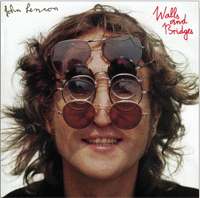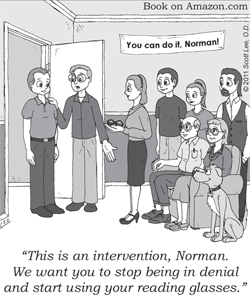Judging a Book By Its Cover
For years, I’ve been looking at the covers of various optometric journals with boring, inane pictures of fingers with a contact lens stuck at the end, or of a diseased eye. They are not attractive. This month’s cover of Review of Optometry (September 2011) has got to be the worst ever—the bloody fingertip. Disgusting!
 There must be a more imaginative and aesthetically pleasing way to design and illustrate a journal cover. Look at a JAMA cover, for example, with its copies of beautiful artworks.
There must be a more imaginative and aesthetically pleasing way to design and illustrate a journal cover. Look at a JAMA cover, for example, with its copies of beautiful artworks.
Please don’t have any more covers with pictures of bloody fingers or diseased eyes or fingers with a contact lens stuck on them. The contact-lens-finger, especially, is stupid and has been overdone ad nauseum.
The inside of your journal is very good and informative. (That’s where the diseased eye pictures should be.) Make the cover so that a person would want to look inside the journal. Maybe your readers could suggest an attractive journal cover? Friendly faces? It doesn’t have to be a finger with a contact lens on the end of it, nor a diseased eye, nor a bloody finger tip. These images do not deserve to be on the cover of a good journal such as yours. Please do something about your covers and improve your image.
Sincerely, but sick of your covers,
—Richard Ingham, O.D.
Palm Harbor, Fla.
Editor’s note: We agree about the contact lens on the fingertip. But we firmly disagree about diseased eyes or bloody fingers on our covers.
Still, we polled our readership via Facebook by asking the question: “Should we have ‘nicer’ covers?”
An overwhelming 85% said, “No, we want more diseased corneas and bloody fingertips” compared to 15% who said, “Yes, we’ve had enough diseased corneas and bloody fingertips.” (Granted, just 20 people voted, but you get the picture.)
We welcome you to offer your insight. To send a Letter to the Editor, e-mail Amy Hellem, editor-in-chief,
ahellem@jobson.com, with “Letter to the Editor” as the subject line.
What the FK?
I found Dr. Robert Simon’s article “
Don’t Let FK Get Carried Away” (October) lacking the good clinical advice that I have come to expect from Review of Optometry. In the case report, he describes a woman suffering from severe filamentary keratitis initially misdiagnosed by her medical doctor and treated incorrectly for one month. Then, to compound her misery, he prescribes a treatment program that takes almost three weeks to produce measurable improvement in her condition and resolution of the corneal filaments.
During my 28 years of optometric practice, I have learned that two days of overnight bandage contact lens wear, in-office cycloplegia, Pred Forte three times per day and unpreserved artificial tears three times per day would have probably resolved the filamentary keratitis and her ocular discomfort by the third day. After that, unpreserved artificial tears and 5% hyperosmotic solution would usually comprise the maintenance therapy.
Punctal plugs could be added to the treatment regimen if the condition returned or if symptoms persisted.
Seven visits over almost 10 weeks to treat filamentary keratitis associated with dry eye syndrome—that’s not the way to practice modern optometry.
—Craig Thomas, O.D.,
Dallas

The Ballad of John and Gary
I enjoyed very much reading about the relationship Gary Tracy, O.D., had with Beatle songwriter and performer John Lennon (“
The Man With Kaliedoscope Eyes,” October). I wish Dr. Tracy would have asked John what was the inspiration for the lyrics to “Nowhere Man.”
Was this man an uncorrected myope, a perceptually-disabled man lost in space where vision therapy could have helped, or just plain meshuggah (nuts)? Seriously, what a nice piece demonstrating how Dr. Tracy was not only John Lennon’s eye doctor but his trusted friend for four years until he died way before his time. R.I.P.
—Jeff Eger, O.D.,
Mesa, Arizona
Stereo Confusion
It was a pleasure to read the excellent and instructive article “
You Can Help Your Patients See 3-D!” by Dr. Dominick Maino in the October issue. One sentence in this outstanding paper, however, contained two minor errors: “Thanks to Charles Wheatstone and his stereoscope (in the 1830s) and the soon-to-follow stereopticon invented by Oliver Wendell Holmes (1862)….”
The first error is using “stereopticon” for “stereoscope.” They are two completely different instruments. The stereopticon is a slide projector, or “magic lantern,” which has two lenses, usually one above the other. It was designed to allow one view to fade out while the next view is fading in. There is no relationship to stereoscopic viewing even though they have been often confused with stereoscopes. These devices date back to the 19th century, and were a popular form of entertainment and education before the advent of moving pictures.
Wheatstone unquestionably invented the mirror stereoscope in 1838. However, the mirror stereoscope was large and clumsy and very expensive to build. In 1849, Sir David Brewster, a brilliant English scientist, conceived the idea of securing separation of the two pictures of a stereograph through the use of prisms. These prisms were set in the eyepiece with the prisms’ bases out. Then a divider was extended forward in the box, between the prisms, so that each eye could see its own picture independent of the other, with the prisms seeming to superimpose the two views. This prism (or lenticular) stereoscope, which Brewster invented, was in principle identical with all popular and scientific stereoscopic viewers used since that time.
Sight Gags by Scott Lee, O.D.

However, the Brewster stereoscope was also clumsy and expensive to build, and it made no provision for changing the distance of the picture from the eye in order to adapt to the focusing ability of the observer.
Meanwhile, Oliver Wendell Holmes, the versatile American physician, scientist and writer, became interested in the use of stereographs. In 1859, Holmes designed a simple type of stereoscope, which dispensed with the boxing in of the picture, placed a hood over the front of the instrument to exclude extraneous light from the eyes, and added a sliding card holder. In Holmes’ own words, “There was not any wholly new principle in its construction, but it proved so much more convenient than any other hand instrument in use.” Holmes’ brilliant changes to Brewster’s stereoscope popularized the use of stereoscopes throughout America, then Europe and eventually the world, for entertainment and educational purposes.
—Sidney Groffman, O.D., M.A.
Professor Emeritus,
SUNY College of Optometry
New York

